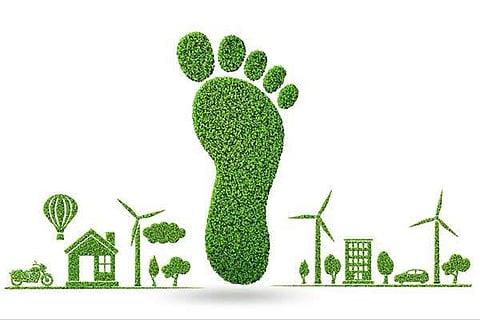

Higher carbon footprint of companies gives higher returns to investors in the short term but could lead to heavy losses in the long term as governments impose regulations on greenhouse gas (GHG) emissions, according to a new mathematical analysis conducted by researchers from IIT Guwahati and IIM Bangalore.
The team from the two top institutions has established a relationship between the carbon footprint of companies and the potential risks of investing in these firms. The researchers did an extensive data analysis of over 200 of the largest listed companies in the American market and the findings have been published in arXiv, a curated research-sharing platform maintained by a team at the US-based Cornell University.
To assess the carbon footprint of the companies, direct GHG emissions of the companies and purchased GHG emissions (in power consumption or heat) were considered. According to the three-member team, as the world looks to move towards a sustainable future and economies everywhere try to reduce their carbon footprint, the future of companies that rely on excessive emissions of greenhouse gases remains uncertain.
The researchers found that most of these companies (71.6 pc) had shown a decline in their carbon emissions in the 2016-2019 period. "It was found that carbon footprint had a positive correlation with the size of companies and revenues. However, the correlation with expenses was found to be slightly less than that with revenue, which they attribute to the higher expenses of switching to renewable energy sources," said Siddhartha Pratim Chakrabarty, professor at Indian Institute of Technology (IIT), Guwahati.
"On analysing the data of annual stock returns, along with data of GHG emissions and other financial data (revenue, debt, and book value, among others), it was found that there exists a 'carbon risk premium' in the stock returns, which means in the short term, higher carbon emissions are found to be inflating the price of the stocks.
"It was found that a higher carbon footprint gave higher returns to investors in the short term," he said.
In the past couple of years, Chakrabarty said, there has seen a lot of research in climate finance and the existence of a carbon risk premium has been confirmed independently by many researchers worldwide.
"The existence of such a premium has been attributed to 'carbon transition risk'. As the adverse effects of climate change become more and more visible, governments around the world may soon impose regulations on GHG emissions or levy higher taxes and charges on companies that contribute significantly to global warming. If this happens, companies will begin losing profits, and in the case of extreme regulations, may even go into debt or bankruptcy, and the value of their shares may plummet. This could result in severe losses for investors, and the ensuing sell-offs could lead to other losses in the broader market," he said.
The researchers claimed that while the estimation of the risk premium has been carried out multiple times in the last few years, there has not been much progress in quantifying future risks, until now.
"In our paper, the collaboration finds a mathematical relationship between the carbon risk premium and the value of the future risk. We studied the risk for different scenarios for when the regulations or 'carbon transition' may happen and found a formula for the maximum exposure of each firm to the transition for different times in the future," said Sankarshan Basu from the Department of Finance and Accounting, Indian Institute of Management (IIM), Bangalore.
"For one family of arrival processes (models for when the transition will happen), they find that the price of the average stock in their data could fall (at most) by 20.65 pc at the transition, if the transition is expected to happen in 10 years' time from now, and 41.3 pc if the transition is expected to happen 20 years from now. The corresponding figures for most polluting firms are 45.04 pc and 90.08 pc respectively," he said. The third member of the research team is Suryadeepto Nag, a BS-MS student from IISER Pune.
The team has demonstrated the different scenarios in which investors could profit from the premium-risk tradeoff as well and show the cases in which it is more profitable to hold on to a stock for the premiums and those where it is more profitable to sell or short the shares.
